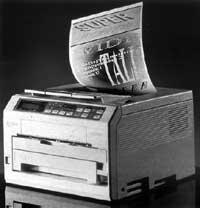Anthropology in support of the technology industry
2003/06/13 Galarraga Aiestaran, Ana - Elhuyar Zientzia

Thanks to anthropology, it was discovered that people exchanged syringes and, to avoid the danger that this implied, invented syringes that are discarded after use. Anthropological research is also used to design health campaigns: In India they want to do a great vaccination against polio, so they will take advantage of the concentration of many people in cricket matches. And for years, technological companies have also resorted to anthropologists.
The American company Xerox was the first to use anthropological research. And one of the results of these investigations is the green button of photocopiers. Today, most photocopiers around the world have that color to take out the photocopy, but the idea was drawn by Xerox. In view of the works that people received to remove a photocopy, a way of facilitating it was sought. In the end, both in the simplest and most complex photocopiers, the way of making photocopies was invented with a single gesture: press the green button and dot.
However, the rest of companies have not only taken the idea of ??the photocopier button to Xerox, but have also copied the way of working this company. Intel, Kodak, Philips, Microsoft and other large companies also take into account ethnographic studies of anthropology and anthropology.
Humanities and technology, closer

Before that, engineers designed the products and normally manufactured them according to their interests. The search for buyers was the responsibility of the marketing department. Now, however, technology companies try to figure out the needs of the buyer and for this, ethnographic studies are very useful.
In ethnographic research, in addition to anthropologists, experts from different disciplines such as psychologists, engineers, sociologists and designers participate. They are usually very deep and sometimes very expensive studies. Normally, to analyze the behavior of people, the help of volunteers is required. Of course, they should try to get the widest group of volunteers possible for all kinds of people to participate in the exam. And the researcher cannot in any way condition the behavior of volunteering. It is also important to collect information without prejudice.
There are several methods to carry out these studies, but above all they use video recordings and interviews to draw conclusions. In video, during the day the volunteers record everything they do at home, at work, in the holidays or in time, while the interviews are long and open. The exam may last a couple of hours, a week, or months.
The goal is to know what people demand from technological tools. In addition, these studies help predict where the product will triumph and where it will not. It must be taken into account that the products, regardless of their design, only make sense in some places. For their habits and ways of life, users can consider this product useful, but it may not make any sense elsewhere, as it is totally useless in their culture and lifestyle.
On other occasions it is nothing more than a matter of tastes, for example, a black and complex mobile phone that has triumphed in North America will not have so much welcome in South America, where they prefer multicolored and easy to use mobile phones. This case shows that globalization is not always commercially beneficial.

It has been frequently analyzed which of the functions offered by mobile phones are used and which are not. Sometimes, complex and complete mobile phones frighten the consumer by their difficulty of use. Ethnographic studies have also been conducted on the size and location of the buttons.
Apart from mobile phones, the customs of people have also influenced the design of computers. Apparently, thanks to an ethnographic research, they realized that Europeans spend a lot of time in the kitchen, and hence the convenience of building smaller computers to facilitate their use in the kitchen. On the other hand, in Japan there are laptops with lacquered black cover. It seems that they are very appreciated for senior executives and are willing to pay much more money for those computers with a shiny cap than for conventional ones.
It is clear that in matters of taste one cannot guess. Or yes? The technological companies strive for it and for it they have the help of anthropologists. The final goal is to create products adapted to the needs of people, so the work of anthropologists can be beneficial to everyone.
Local habits as a source of new ideas In China, in no-phone areas, Motorola researchers saw that entrepreneurs used people's search engines to send coded messages. To respond to this need, Motorola developed tools capable of sending messages in both ways. In Alaska it was detected that salmon fishermen, to write notes on the laptop, were leaving the boat cabin. For this reason, Intel manufactured microprocessors adapted to low temperatures. As for the Caspian Sea, they realized that people learned to read the barcodes of mobile phones. Apparently, those made in the US. They were better than others, and in this way the ones made in the United States differed from others. Knowing this, perhaps a company outside the United States would like to make mobile in that country if it wants to sell in that market. |
Published in Zabalik.

Gai honi buruzko eduki gehiago
Elhuyarrek garatutako teknologia





